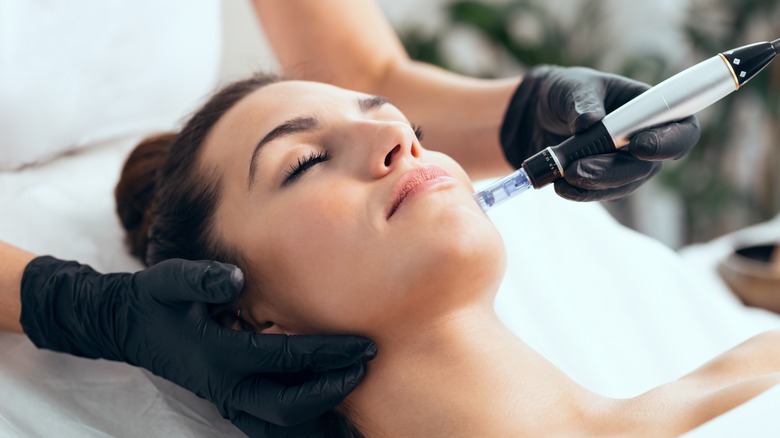The Workout Schedule Step You Should Take To Ensure Your Cosmetic Injectables Last
Anyone who has considered having cosmetic injectables done, such as Botox or various fillers, may be aware of the fact that the effect they offer isn't exactly permanent. Granted, that doesn't necessarily mean you know how long some may last, which is surely valuable info. After all, who wants to bother having needles around their face if the result is short-lived?
For instance, if you opt for a little Botox, then it will likely take around three to five days before you see the results it should bring about, according to Quinn Plastic Surgery & Aesthetic Center. Once it's settled in, you can expect it to keep doing its job for three to four months, although, it can last for up to six months for some fortunate folks. Of course, you could also consider dermal fillers, which take more time to take effect while also lasting longer. Although it might take a week or two before the fillers are fully doing their thing, what you end up seeing — and hopefully loving — can be enjoyed for six months in some cases, and more than two years in other situations.
Although there are various factors that will affect how long your filler will last, there are also many things you can do to attempt to keep it around for as long as possible. That includes taking a certain step when it comes to your workout schedule, which can help ensure your injectables last.
Wait a certain amount of time to workout after injectables
Having cosmetic injectables done may make you feel wonderfully refreshed, intoxicatingly invigorated, and ready to face whatever might be next in your busy schedule. However, if that happens to include working out, then you may need to rearrange your plans.
To be exact, you shouldn't do any kind of exercise for four or more hours after your injectables appointment has wrapped up, Melanie Palm, M.D., a board-certified dermatologist in San Diego, CA, told Women's Health. If you've had filler done, then it's best to wait a full day before tackling your usual workout and bump that up to two days if you opted for what's known as a neuromodulator. Palm explained why this step is necessary, saying, "When we exercise, our heart rate increases, which puts increased pressure on our blood vessels. If there has been the formation of a small amount of swelling or bruising, then exercising immediately after an injectable procedure is likely to make it more significant."
Avoiding excessive and unnecessary bruising is surely enough of a reason to skip a workout or two. Granted, there's another reason that you should probably know about before you think about exercising after getting injectables.
Some injectables can move during a workout
Whatever workout routine you happen to prefer, it surely gets your body moving in just the right ways. Unfortunately, it can also cause your injectables to move if you're not careful. Take for example what you might face with Botox.
"After injection, it takes a few days for that preservative protein to disassociate from the active botulinum toxin molecule," Alan Durkin, M.D., the founder of Ocean Drive Plastic Surgery, explained to Self. During this period and as a part of the overall process, the injectable will normally end up attaching itself to the muscle where it's been placed. This is obviously how it stays exactly where you want it to be. "However, during the timeframe between injection and Botox binding [to the muscle], there is an opportunity for the Botox to 'migrate' as it has not bound to the muscle," Durkin added. That means that it can end up moving away from the target spot and into areas where you don't want it to be. Durkin specifically noted that working out — such as quick jumps or other fast movements — can make the situation much worse.
If you've had the lines between your brows done, then you especially want to be careful. This is a place on your face that is particularly prone to suffering from migrating injectables. Frankly, it has even been known to cause eyelids to droop, which is definitely not the intended result and something you likely want to avoid.


